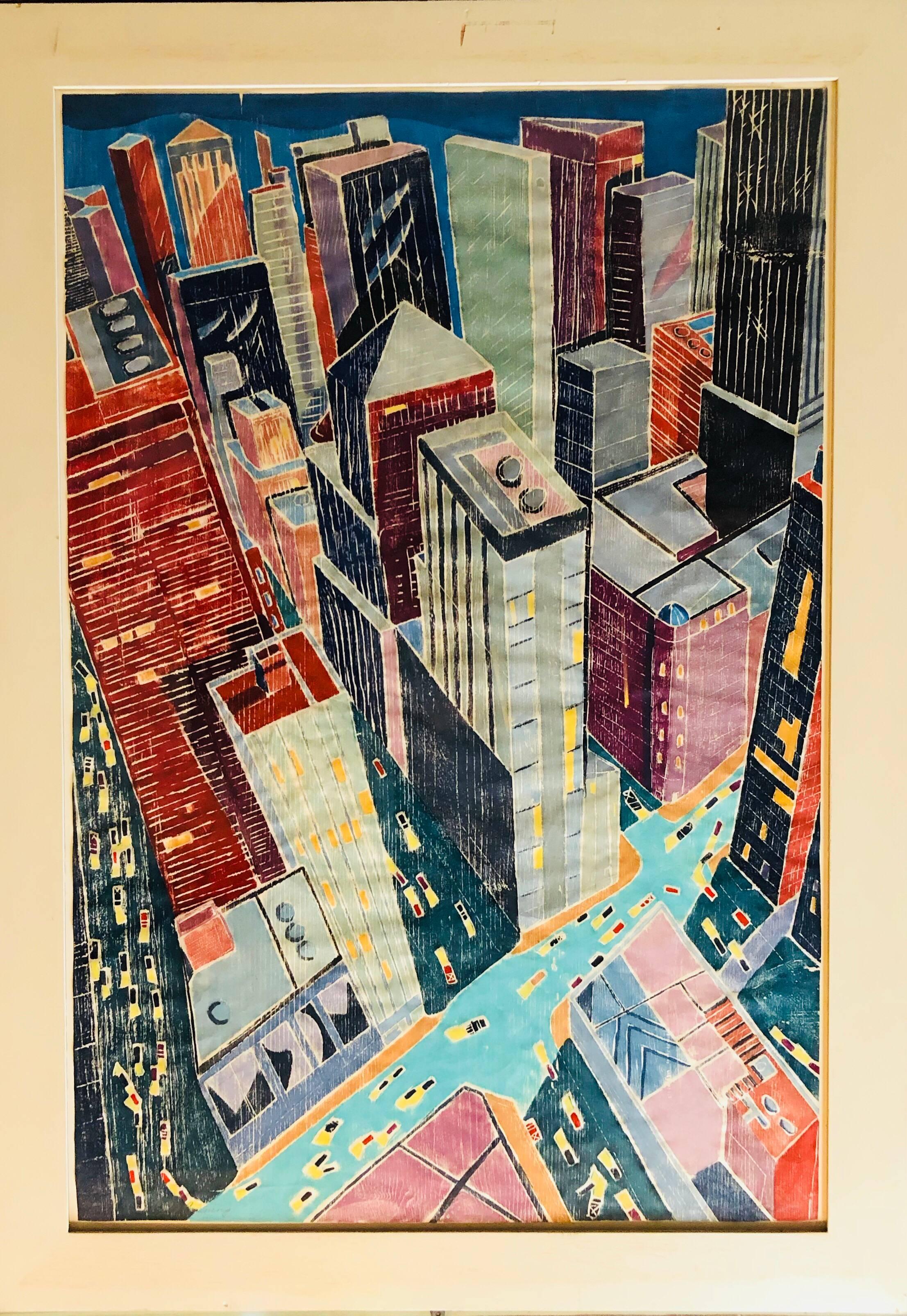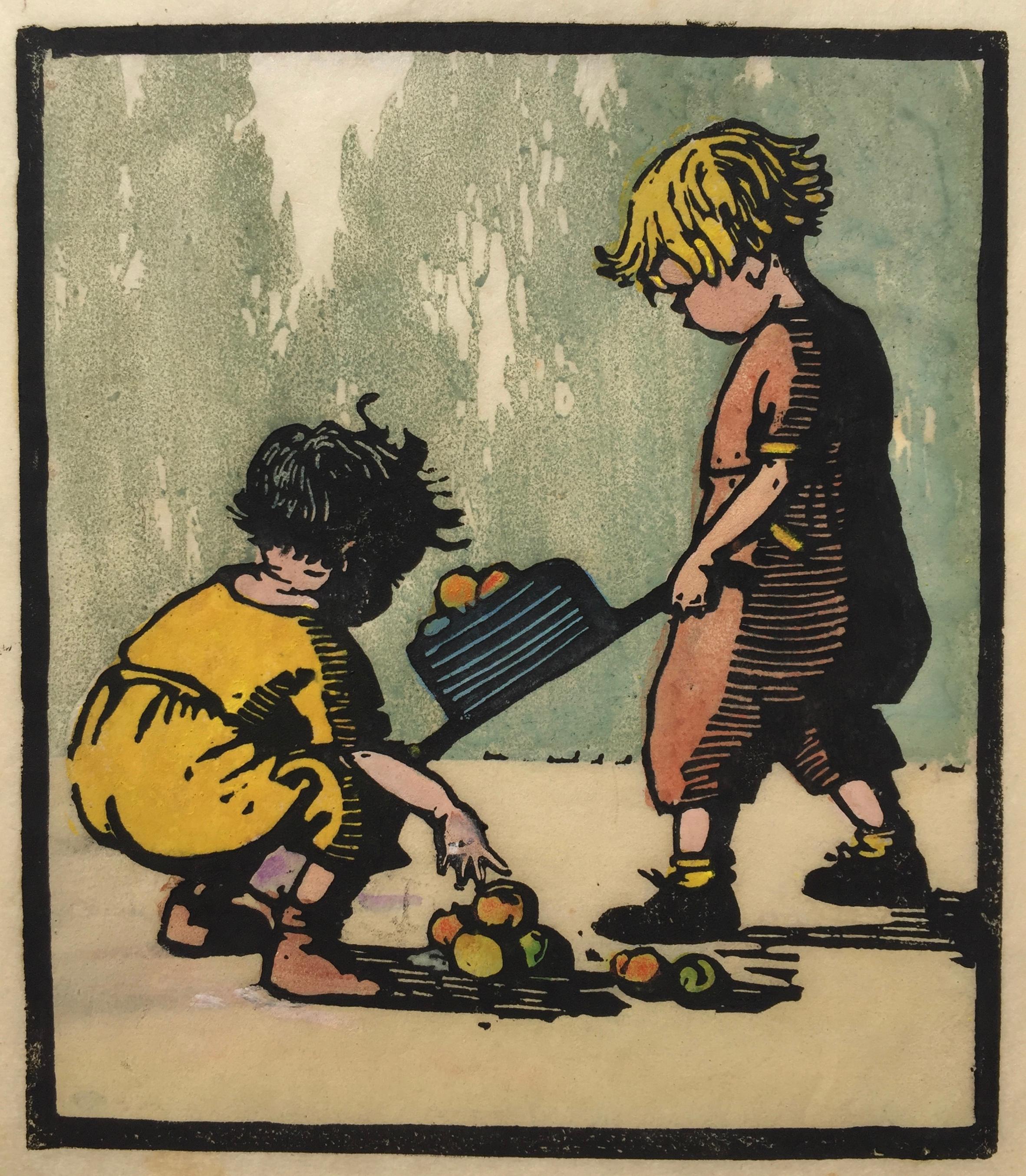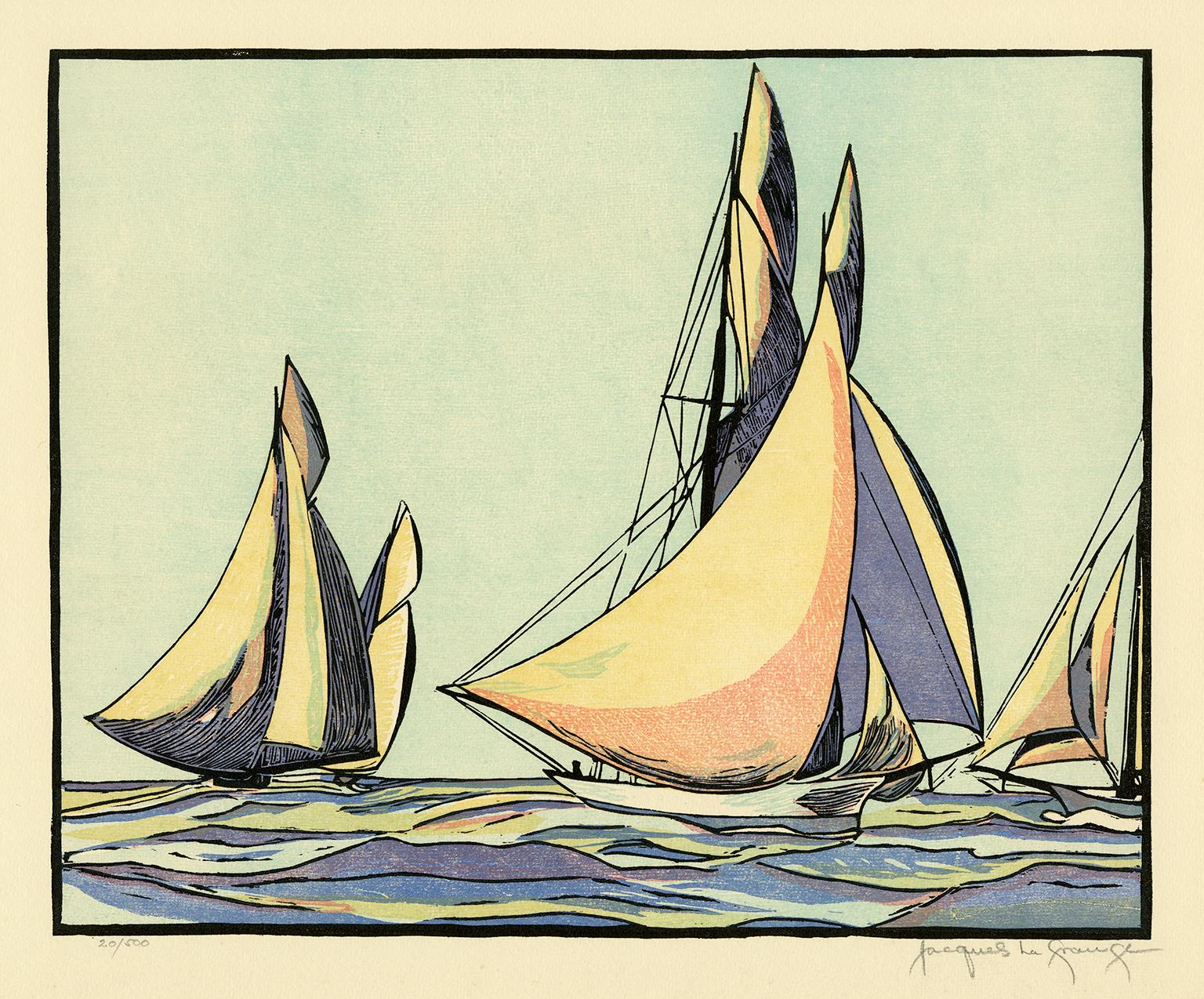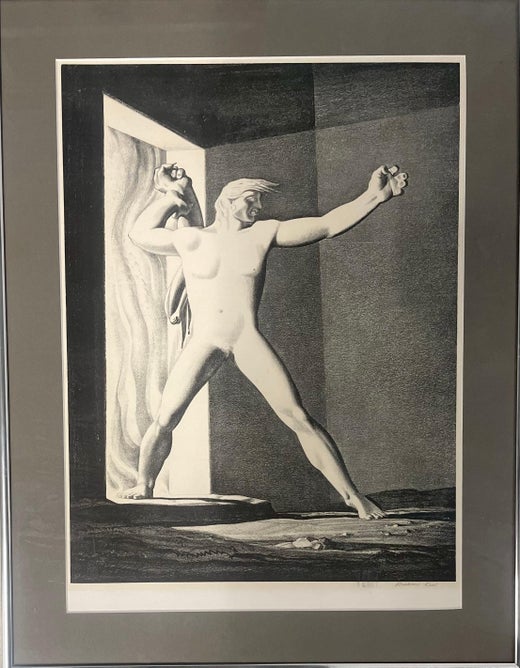Items Similar to Hail and Farewell
Want more images or videos?
Request additional images or videos from the seller
Rockwell KentHail and Farewell1930
1930
About the Item
Rockwell Kent
"Hail and Farewell" 1930
Wood Engraving on Paper
Signed in Pencil Lower Right
Sheet Size: 14 3/8 x 11 1/4 in.
Image Size: 8 x 5 1/2 in.
Framed Size: 17.5 x 13.5 in.
Growing up in a genteel family in New York City, Rockwell Kent was a member of the rugged realist school of landscape painters as well as a popular illustrator and printmaker. His 1930 illustrations for Moby Dick are among his most lasting achievements. He was the first American artist to have work exhibited in the Soviet Union, a reflection of his Communist Party sympathies, which earned him the Lenin Peace Prize in 1967. This espousal of radical politics caused his career to suffer badly in the '50s because his leftist views caused him disdain among many Americans. However, his work, reflecting both realism and modernism, has earned increasing attention from American art historians.
His subject matter is wide-ranging including scenes of Maine's Monhegan Island, the Adirondack Mountains, book illustrations, and commercial art renderings for companies including General Electric, Rolls Royce, and Westinghouse. Although his first love was painting, in addition to illustration, he also did fabric, ceramic, and jewelry designs, and spent time as a dairy farmer, carpenter, home builder, and lobster fisherman.
His father, Rockwell Kent, Sr. was a partner in a prominent New York City law firm and an entrepreneur in Central American mining investments. His mother, Sara Ann Holgate, was the niece and surrogate daughter of James and Josephine Banker, one of New York's first-millionaire families. Young Rockwell's early childhood was divided between Hudson River Valley, Long Island, and New York City homes, each brimming with cultured surroundings and distinguished persons. However, that comfortable life came to an abrupt end in 1887 with the death from typhoid fever of Rockwell Kent, Sr., which left the mother with Rockwell Jr., age 5, and another son, and a daughter who was born shortly after the father's death.
Now in a readjusted circumstance of genteel poverty, Kent was encouraged in his art talent by an aunt, Josie Banker who was a successful ceramic decorator and with whom he traveled in Europe. He studied mechanical drawing and woodworking at the Horace Mann School in New York, and this experience gave him a life-long respect for craftsmanship that is evident in his paintings and drawings.
It was also during these years that he developed his understanding of discrepancies between social classes. He later recalled: "When I was a young fellow, I was very much disturbed by seeing some people with lots of money and lots of people with no money" (Smithsonian, 8/2000 by Scott Ferris).
From 1900-1903, he joined William Merritt Chase's classes at Shinnecock and then entered the New York School of Art studying with Robert Henri and becoming close friends with George Bellows and Edward Hopper. His special mentor, however, was Abbott Thayer with whom he painted in New Hampshire and whose home was a place of wide-ranging discussion about topics including German lieder and Nordic sagas. All of this encouraged Kent to travel extensively. Later Kent married Kathleen Whiting, the niece of Thayer, and they had five children. In 1919, after returning from his Alaskan adventure, Kent decided to move his family out of New York City. Searching for a farm they could afford, Kent and Kathleen, found an isolated property high on the southern spur of Mt. Equinox, near Arlington, Vermont. It was called Egypt Farm. But Vermont was not the Eden-like existence he had envisioned and his infidelities and long absences eventually led to divorce. He was married two other times.
He was an inveterate traveler whose wanderlust created subjects from a wide variety of locations and which caused him to be literally the starving artist, dependent upon outside sources for money. One of his supporters was Duncan Phillips, founder of the Phillips Collection in Washington D.C. who for nine years gave Kent $300. a month in exchange for first selection of two paintings a year.
Much influenced in Ireland by Thayer, Kent's artistic focus became landscape painting and the relationship between nature and humanity. He spent much time on Monhegan Island in Maine, a place he first visited in 1905 at the suggestion of Robert Henri. Although Kent stayed only until 1910, the place became closely associated with his name. Between 1915 and 1935, he visited Newfoundland, Alaska, Tierro del Fuego, France, Ireland, and Greenland. He also wrote designed, and illustrated a number of travelogues.
In 1927, after his marriage to Frances Lee, he settled into a parcel of farmland near Ausable Forks, New York, where he built a studio and felt at home for the first time during his painting career. There he and his wife hosted numerous gatherings of prominent New York people including the Pulitzers, Putnams, and Paul Robeson, Pete Seeger, and John Dos Passos.
In 1907, his first exhibition was held in New York, and he also exhibited with George Bellows and John Steuart Curry and members of The Eight before 1920. From 1918, he did numerous wood engravings and lithographs, and he left eighty-six paintings and hundreds of drawings, now scattered among museums. In Fall, 1998, the Monhegan Museum held a retrospective of his oil and ink paintings.
Sources:
Much of the above information is from Scott R. Ferris, specialist in the art of Rockwell Kent. He wrote most of the catalog entry for the Sotheby's auction (12/3/03), for the sale of Blue Day and has written the foreword for the reprinted edition of Kent's book, Salamina (Wesleyan University Press. Oct. 2003). On 25 May 2003, "CBS Sunday Morning" aired an article on Kent, and Ferris was interviewed along with Kent's son Gordon, and artist, Jamie Wyeth.
- Creator:Rockwell Kent (1882-1971, American)
- Creation Year:1930
- Dimensions:Height: 17.5 in (44.45 cm)Width: 13.5 in (34.29 cm)
- Medium:
- Movement & Style:
- Period:
- Condition:
- Gallery Location:Missouri, MO
- Reference Number:1stDibs: LU74735027242
Rockwell Kent
Rockwell Kent, (1882-1971) was born in Plattsburgh, New York). As a painterand printmaker his work was captured scenes of nature and adventure with a sense of drama that made him one of the most popular American artists of the first half of the 20th century. Kent studied architecture at Columbia University but turned to painting and was a pupil of William M. Chase, Robert Henri, and Abbott Thayer. Best known as an artist and illustrator he worked as an architectural draftsman, as a lobsterman and carpenter on the coast of Maine, and as a ship’s carpenter. He explored the waters about Tierra del Fuego in a small boat and lived in Newfoundland, Alaska, and Greenland, drawing heavily upon these experiences for his paintings and travel books. Kent’s human figures, which appear sparingly in his work, often signify mythic themes, such as heroism, loneliness, and individualism.
About the Seller
5.0
Vetted Seller
These experienced sellers undergo a comprehensive evaluation by our team of in-house experts.
Established in 1970
1stDibs seller since 2017
141 sales on 1stDibs
Typical response time: 22 hours
- ShippingRetrieving quote...Ships From: Missouri, MO
- Return PolicyA return for this item may be initiated within 2 days of delivery.
More From This SellerView All
- ManBy Elizabeth CatlettLocated in Missouri, MOElizabeth Catlett “Man” 1975 (The Print Club of Cleveland Publication Number 83, 2005) Woodcut and Color Linocut Printed in 2003 at JK Fine Art Editions Co., Union City, New Jersey Signed and Dated By The Artist Lower Right Titled Lower Left Ed. of 250 Image Size: approx 18 x 12 inches Elizabeth Catlett (1915-2012) is regarded as one of the most important women artists and African American artists of our time. She believed art could affect social change and that she should be an agent for that change: “I have always wanted my art to service black people—to reflect us, to relate to us, to stimulate us, to make us aware of our potential.” As an artist and an activist, Catlett highlighted the dignity and courage of motherhood, poverty, and the working class, returning again and again to the subject she understood best—African American women. The work below, entitled, “Man”, is "carved from a block of wood, chiseled like a relief. Catlett, a sculptor as well as a printmaker, carves figures out of wood, and so is extremely familiar with this material. For ‘Man’ she exploits the grain of the wood, allowing to to describe the texture of the skin and form vertical striations, almost scarring the image. Below this intense, three-dimensional visage parades seven boys, printed repetitively from a single linoleum block in a “rainbow roll” that changes from gold to brown. This row of brightly colored figures with bare feet, flat like a string of paper dolls, raise their arms toward the powerful depiction of the troubled man above.” Biography: Elizabeth Catlett (1915-2012) Known for abstract sculpture in bronze and marble as well as prints and paintings, particularly depicting the female figure, Elizabeth Catlett is unique for distilling African American, Native American, and Mexican art in her work. She is "considered by many to be the greatest American black sculptor". . .(Rubinstein 320) Catlett was born in Washington D.C. and later became a Mexican citizen, residing in Cuernavaca Morelos, Mexico. She spent the last 35 years of her life in Mexico. Her father, a math teacher at Tuskegee Institute in Alabama, died before she was born, but the family, including her working mother, lived in the relatively commodious home of his family in DC. Catlett received a Bachelor of Arts degree from Howard University, where there was much discussion about whether or not black artists should depict their own heritage or embrace European modernism. She earned a Master of Fine Arts degree in 1940 from the University of Iowa, where she had gone to study with Grant Wood, Regionalist* painter. His teaching dictum was "paint what you know best," and this advice set her on the path of dealing with her own background. She credits Wood with excellent teaching and deep concern for his students, but she had a problem during that time of taking classes from him because black students were not allowed housing in the University's dormitories. Following graduation in 1940, she became Chair of the Art Department at Dillard University in New Orleans. There she successfully lobbied for life classes with nude models, and gained museum admission to black students at a local museum that to that point, had banned their entrance. That same year, her painting Mother and Child, depicting African-American figures won her much recognition. From 1944 to 1946, she taught at the George Washington Carver School, an alternative community school in Harlem that provided instruction for working men and women of the city. From her experiences with these people, she did a series of paintings, prints, and sculptures with the theme "I Am a Negro Woman." In 1946, she received a Rosenwald Fellowship*, and she and her artist husband, Charles White, traveled to Mexico where she became interested in the Mexican working classes. In 1947, she settled permanently in Mexico where she, divorced from White, married artist Francisco Mora...Category
Late 19th Century American Modern Figurative Prints
MaterialsWoodcut, Linocut
- The Blue BicycleBy Will BarnetLocated in Missouri, MOThe Blue Bicycle, 1979 Will Barnet (American, 1911-2012) 26 x 25.5 inches 41 x 40 inches with frame Titled Lower Center Signed and Dated Lower Right Edition 41/300 Lower Left From B...Category
1970s American Modern Figurative Prints
MaterialsLithograph
- U.S. Open at OakmontBy LeRoy NeimanLocated in Missouri, MOU.S. Open at Oakmont Leroy Neiman (American, 1921-2012) Signed in pencil lower right Edition 63/300 lower left 27.5 x 39 inches 39.25 x 51 inches with frame Known for his bright, co...Category
20th Century American Modern Landscape Prints
MaterialsColor, Lithograph
- Cove at VintageBy LeRoy NeimanLocated in Missouri, MOCove at Vintage Leroy Neiman (American, 1921-2012) Signed in pencil lower right Edition 237/375 lower left 34 x 36.5 inches 43 x 45.5 inches with frame Known for his bright, colorfu...Category
20th Century American Modern Landscape Prints
MaterialsColor, Lithograph
- The 18th at Pebble BeachBy LeRoy NeimanLocated in Missouri, MOThe 18th at Pebble Beach Leroy Neiman (American, 1921-2012) Signed in pencil lower right Edition 176/400 lower left 26 x 43 inches 37.25 x 54.5 inches with frame Known for his brigh...Category
20th Century American Modern Landscape Prints
MaterialsColor, Lithograph
- Study/Falling Man (Series I)By Ernest Tino TrovaLocated in Missouri, MOStudy/Falling Man (Series I), 1967 By. Ernest Tino Trova (American, 1927-2009) 24 x 24 inches Wrapped on Foam Core Signed Artist Proof Lower Right Ernest Tino Trova (American, 1927-...Category
1960s American Modern Abstract Prints
MaterialsScreen
You May Also Like
- City Evening, Large Scale Whiteline Woodcut New York City at Night ed. 25By Aline FeldmanLocated in Surfside, FLAline Feldman was born in 1928 and grew up in Kansas. She studied design and printmaking at Washington University in St. Louis under Werner Drewes and Fred Becker, respectively. She studied painting at Indiana University...Category
1980s American Modern Figurative Prints
MaterialsWoodcut
- FRUIT FOR SALEBy Frances H. GearhartLocated in Santa Monica, CAFRANCES H. GEARHART and Sisters (THE GEARHARTS) FRUIT FOR SALE c.1928 Color block print. Unsigned. This is an original block print from “Let’s Play”, an intended but unpublished children’s book done in collaboration with her sisters Edna and May in 1928. Image 8 x 7 inches. On a tissue thin laid paper. Irregular sheet 9 3/8 x 8 1/2. The entire series consisted of over 20 children's images. There were very few printed. The editions of the various children varied but likely no more than 50. This impression very well printed with good colors, Very good condition. The margins are likely as issued with the irregular edges. The margins and paper used for this series varies from one print to the next. A bit of tape remnants at top center sheet edge. A very nice example of this print. It is not unusual for impressions of this series to be unsigned, although many are signed "The Gearharts" The Provenance of this example is fascinating. It was acquired from a gentleman who knew the Gearharts as a child in the early 50's in Pasadena. It was part of a collection given to him by Frances. In his adult years he was in the military and took the collection with him as he traveled around Europe, After 81 years, based on the original prints, this book was published by the “California Book...Category
1920s American Modern Figurative Prints
MaterialsWoodcut, Linocut
- 'Humming Birds and Orchids' — Vintage White Line Color WoodcutLocated in Myrtle Beach, SCWuanita Smith, 'Humming Birds and Orchids', white-line color woodcut, circa 1930, edition 50. Signed and titled in pencil. Annotated '50 edition', 'no 5'...Category
1930s American Modern Figurative Prints
MaterialsWoodcut
- 'After the Start' — America's Cup, 1893By Jacques La GrangeLocated in Myrtle Beach, SCJacques La Grange, 'After the Start', color woodcut, edition 500, 1934. Signed and numbered '25/500' in pencil. A fine impression, with fresh colors, on cream wove paper, with margins (1 1/4 to 1 5/8 inches), in excellent condition. Archivally matted to museum standards, unframed. A work from La Grange’s celebrated series of woodcuts 'Drama and Color in the America's Cup Races'. Image size 9 5/8 x 12 1/8 inches (244 x 384 mm); sheet size 12 1/4 x 15 1/8 inches (311 x 384 mm). ABOUT THE ARTIST Jacques La Grange was born in Clanwilliam (near Cape Town) in South Africa in 1895. He studied at London University and later immigrated to the United States. La Grange established himself as a painter, illustrator, and printmaker specializing in nautical subjects. He and his wife, Helen La Grange, published 'Drama and Color in the America's Cup Races' in 1934 and 'Clipper Ships of America and Great Britain 1833-1869', in 1936. Both were deluxe hardcover limited edition volumes with signed original color woodblock prints. La Grange had solo exhibitions at the Buchanan Gallery in 1929, the Babcock Gallery and the 56th Street Gallery in New York in 1930, and at the Nicholas Roerich...Category
1930s American Modern Figurative Prints
MaterialsWoodcut
- 'The Yankee' — America's Cup, 1934By Jacques La GrangeLocated in Myrtle Beach, SCJacques La Grange, 'The Yankee', color woodcut, edition 500, 1934. Signed and numbered '25/500' in pencil. A fine impression, with fresh colors, on cream wove paper, with margins (1 1/8 to 1 1/4 inches), in excellent condition. A work from La Grange’s celebrated series of woodcuts 'Drama and Color in the America's Cup Races'. Image size 10 x 10 11/16 inches (254 x 271 mm); sheet size 12 1/4 x 13 1/4 inches (311 x 337 mm). Archivally matted to museum standards, unframed. When the artist created this print in 1934, the 'Yankee' was one of the most promising yachts eligible for the America's Cup but ultimately 'Rainbow' was chosen to defend against England's 'Endeavor' in that year's race. The 'Endeavor' was built for Thomas Sopwith who used his aviation design expertise to ensure the yacht was the most advanced of its day with a steel hull and mast. She was launched in 1934 and won many races in her first season but the Cup challenge was blighted by a strike of Sopwith's professional crew prior to departing for America. Forced to rely mainly on keen amateurs, who lacked the necessary experience, the campaign failed. 'Rainbow' won the series 4–2. This was one of the most contentious of the America's Cup battles and prompted the headline "Britannia rules the waves and America waives the rules." ABOUT THE ARTIST Jacques La Grange was born in Clanwilliam (near Cape Town) in South Africa in 1895. He studied at London University and later immigrated to the United States. La Grange established himself as a painter, illustrator, and printmaker specializing in nautical subjects. He and his wife, Helen La Grange, published 'Drama and Color in the America's Cup Races' in 1934 and 'Clipper Ships of America and Great Britain 1833-1869', in 1936. Both were deluxe hardcover limited edition volumes with signed original color woodblock prints. La Grange had solo exhibitions at the Buchanan Gallery in 1929; the Babcock Gallery and the 56th Street Gallery, New York, in 1930; and at the Nicholas Roerich...Category
1930s American Modern Figurative Prints
MaterialsWoodcut
- 'The Magic Is Ahead' — America's Cup, 1870By Jacques La GrangeLocated in Myrtle Beach, SCJacques La Grange, 'The Magic Is Ahead, 1870', color woodcut, edition 500, 1934. Signed and numbered '21/500' in pencil. A fine impression, with fresh colors, on cream wove paper, wi...Category
1930s American Modern Figurative Prints
MaterialsWoodcut
Recently Viewed
View AllMore Ways To Browse
Mother And Two Children
Kent Modern
Friends And Founders
William Kent
Rockwell Vintage
Five Wood And Fabric
Rockwell Signed
Adirondack Mountains
General Electric Vintage
Rockwell Print
50s Illustration Art
Vintage Bellows
The Carpenters Son
1920 Fork
Monhegan Island
Monhegan Island Art
Lobster Day
Phillip Paper And Ink






